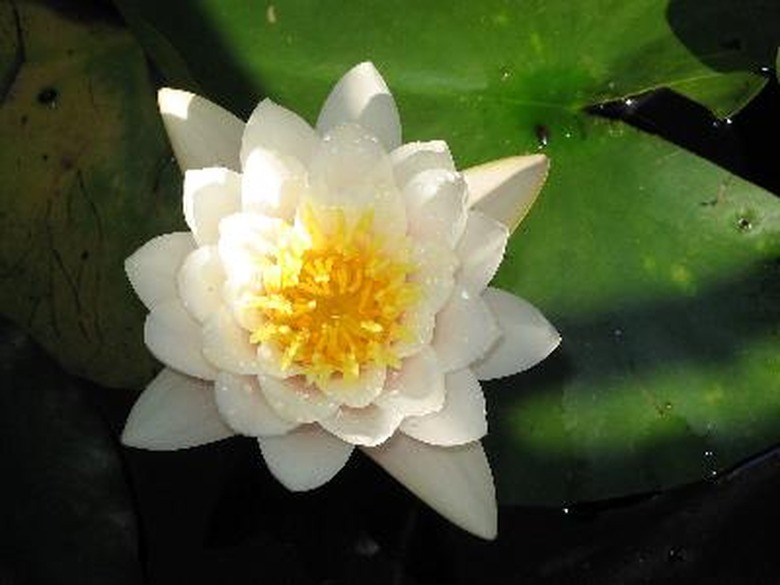How Do Water Lilies Obtain Food & Derive Energy From It?
Water lilies (Nymphaea) — both tropical species and hardy northern types — are so lovely that 18th-century biologist Carolus Linnaeus named the family of flowers after the nymphs of Greek mythology. Nymphaea have inspired legends worldwide to explain their unusual choice of home. One Native American story says the water lily is a star maiden who visited Earth and accidentally fell in a lake only to emerge as the flower. For the everyday observer, another question arises about how these plants obtain the food that energizes their beauty.
Soil Nutrition
True, floating aquatic plants, such as the water hyacinth, gain food from water instead of soil. But water lilies only appear to drift carefree atop placid waters. Their blossoms and large, cleft leaves are attached to lanky, tuberous stalks that are supported by water. The stalks lead to iris-like rhizomes that absorb nutrients by taking root in the muddy bottoms of placid ponds, lakes and rivers. They are also grown in the fertilized clay loam of movable containers placed underwater in man-made ponds.
- Water lilies (Nymphaea) — both tropical species and hardy northern types — are so lovely that 18th-century biologist Carolus Linnaeus named the family of flowers after the nymphs of Greek mythology.
- True, floating aquatic plants, such as the water hyacinth, gain food from water instead of soil.
Photosynthesis
Similar to most aquatic plants, water lilies need lots of sunlight for photosynthesis. The plant uses the sunlight, water and carbon dioxide to create carbohydrates with the help of chlorophyll in the lily pads. The Springdale Water Gardens website says that although a pond in full sunlight is optimal for water lilies, five hours of sunlight (preferably in the afternoon) will do.
Clay Soil for Containers
The University of Illinois notes that container-planted water lilies grow best in a clay loam soil that is well-balanced nutritionally, similar to what you might find in your garden. It notes that commercial potting mixes are too light and not rich enough for the plants. Water lilies that are planted directly in pond soil may grow out of control, interfere with pond-lining materials, or die during cold weather. Container planting allows gardeners to move the flowers easily for re-potting or winter storage.
- Similar to most aquatic plants, water lilies need lots of sunlight for photosynthesis.
- The University of Illinois notes that container-planted water lilies grow best in a clay loam soil that is well-balanced nutritionally, similar to what you might find in your garden.
To avoid loss of nutrients and muddying of pond water, containers with holes should be lined with burlap before being filled with soil. Kit Knotts of the Water Garden International website recommends adding a layer of sand and then gravel on top of the soil to anchor the plant and minimize loss of soil.
Fertilizing
When first planting a water lily in late spring, the University of Illinois says slow-release fertilizer tablets or granular fertilizer should be added. The amount should equal 4 oz. of granular fertilizer per cubic foot of soil. Afterward, fertilizer should be added once a month through August. The university notes that it is easy to press tablets into the soil, but that granular fertilizer can also be easily applied by wrapping it in a biodegradable coffee filter and burying it in the container.
- To avoid loss of nutrients and muddying of pond water, containers with holes should be lined with burlap before being filled with soil.
- The university notes that it is easy to press tablets into the soil, but that granular fertilizer can also be easily applied by wrapping it in a biodegradable coffee filter and burying it in the container.
